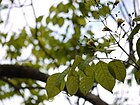Note: This is a project under development. The articles on this wiki are just being initiated and broadly incomplete. You can Help creating new pages.
Stereospermum chelonoides - Patala
Patala has a medium height of 9-18 m and its bark is grey or dark brown. The horizontally furrowed tree exfoliates in large, flat scales. The leaves are simple pinnate, having a length of 30-60 cm and they have 3-4 pairs of leaflets also.
Uses
Indigestion, Hiccups, Vomiting, Diarrhea, Pain, Cough, Fever, Diabetes, Liver disorders, Asthma, Lower blood sugar, Cholesterol, Parkinson disease.
Parts Used
Chemical Composition
The roots of Stereospermum suaveolens were reported to contain p-coumaric acid, Triacontanol,3- cetyl alcohol, Oleic, Palmitic, Stearic acid, Lapachol, Dehydroalpha-lapachone and Dehydrotectol in root heartwood; β-sitosterol and n-triacontal in root bark.[1]
Common names
| Language | Common name |
|---|---|
| Kannada | Adri, Bilee paadari, Billa |
| Hindi | Pad, Padal, Padaria, Padiala |
| Malayalam | Kariyam, Kuberakshi, Padiri |
| Tamil | Ambu, Ambuvagini |
| Telugu | Ambuvasini, Kakkisa, Kalagoru |
| Marathi | NA |
| Gujarathi | NA |
| Punjabi | NA |
| Kashmiri | NA |
| Sanskrit | Abhipriya, Alivallabha, Ambuvasani |
| English | Adakapari, Bignonia chelonoides |
Properties
Reference: Dravya - Substance, Rasa - Taste, Guna - Qualities, Veerya - Potency, Vipaka - Post-digesion effect, Karma - Pharmacological activity, Prabhava - Therepeutics.
Dravya
Rasa
Guna
Veerya
Vipaka
Karma
Prabhava
Habit
Identification
Leaf
| Kind | Shape | Feature |
|---|---|---|
| compound | imparipinnate | Leaves are opposite, rachis 150-450 mm long, pubescent, slender, swollen at base. |
Flower
| Type | Size | Color and composition | Stamen | More information |
|---|---|---|---|---|
| bisexual | 18 mm long | pink | Flowers are in drooping panicles, pubescent |
Fruit
| Type | Size | Mass | Appearance | Seeds | More information |
|---|---|---|---|---|---|
| capsule | 30-60 x 0.5 cm | Fruits are grey, lenticellate. | seeds upto 5 | Fruiting throughout the year |
Other features
List of Ayurvedic medicine in which the herb is used
Where to get the saplings
Mode of Propagation
How to plant/cultivate
Commonly seen growing in areas
Moist parts, Deciduous forests, Humid climate, Hot climate, Lateritic loamy soils, Sandy black soils.
Photo Gallery
References
- ↑ "Chemical constituents"
- ↑ "Morphology"
- ↑ [ "Cultivation detail"]
External Links
- Ayurvedic Herbs known to be helpful to treat Indigestion
- Ayurvedic Herbs known to be helpful to treat Hiccups
- Ayurvedic Herbs known to be helpful to treat Vomiting
- Ayurvedic Herbs known to be helpful to treat Diarrhea
- Ayurvedic Herbs known to be helpful to treat Pain
- Ayurvedic Herbs known to be helpful to treat Cough
- Ayurvedic Herbs known to be helpful to treat Fever
- Ayurvedic Herbs known to be helpful to treat Diabetes
- Ayurvedic Herbs known to be helpful to treat Liver disorders
- Ayurvedic Herbs known to be helpful to treat Asthma
- Ayurvedic Herbs known to be helpful to treat Lower blood sugar
- Ayurvedic Herbs known to be helpful to treat Cholesterol
- Ayurvedic Herbs known to be helpful to treat Parkinson disease
- Herbs with Seeds used in medicine
- Herbs with Stem used in medicine
- Herbs with Leaves used in medicine
- Herbs with Roots used in medicine
- Herbs with common name in Kannada
- Herbs with common name in Hindi
- Herbs with common name in Malayalam
- Herbs with common name in Tamil
- Herbs with common name in Telugu
- Herbs with common name in Sanskrit
- Herbs with common name in English
- Habit - Tree
- Index of Plants which can be propagated by Seeds
- Herbs that are commonly seen in the region of Moist parts
- Herbs that are commonly seen in the region of Deciduous forests
- Herbs that are commonly seen in the region of Humid climate
- Herbs that are commonly seen in the region of Hot climate
- Herbs that are commonly seen in the region of Lateritic loamy soils
- Herbs that are commonly seen in the region of Sandy black soils
- Herbs
- Ayurvedic herbs that don't have seed photos
- Bignoniaceae






